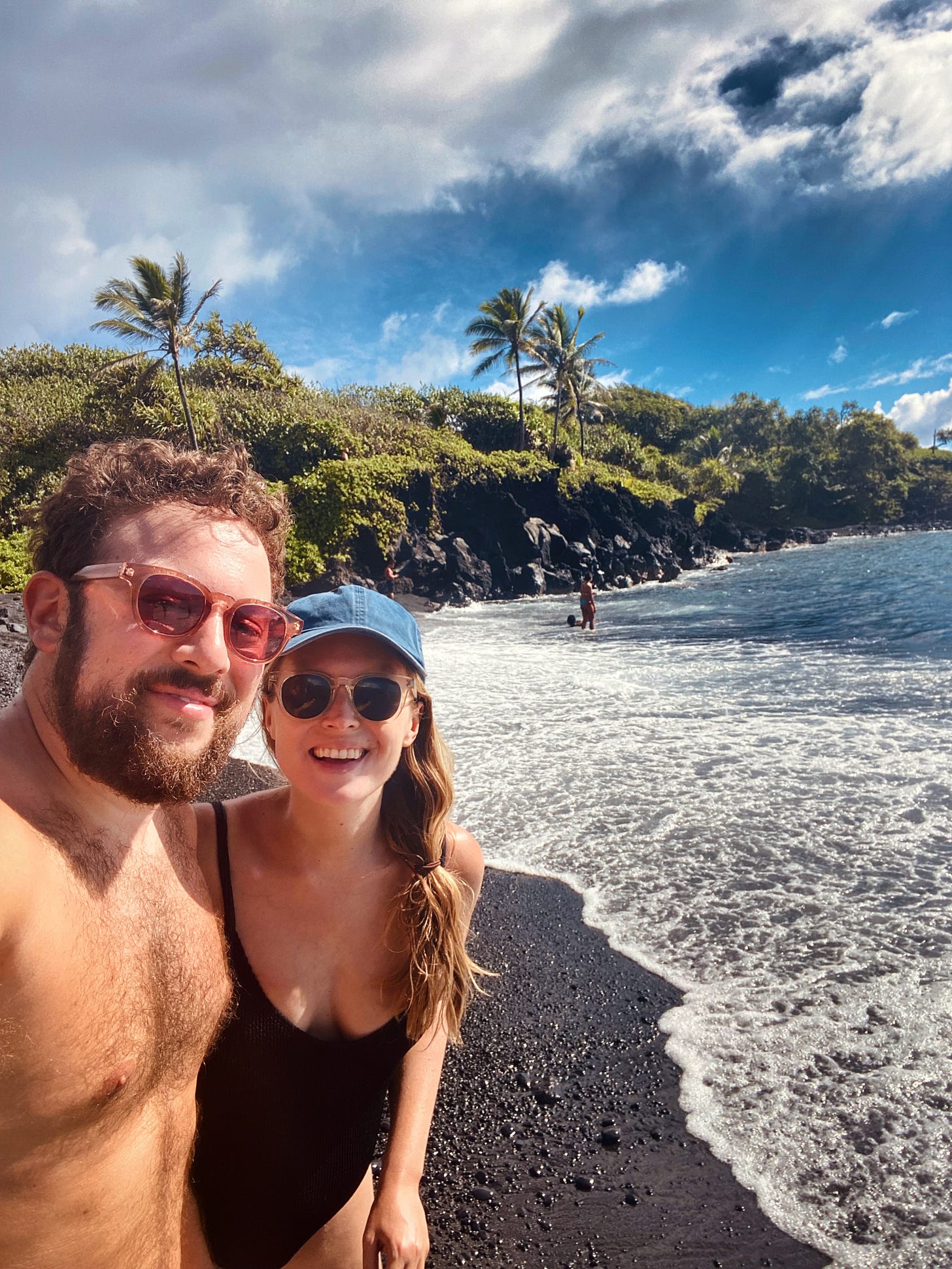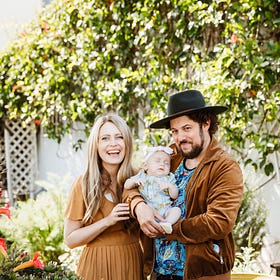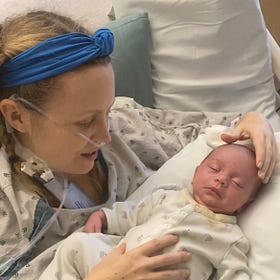Hi Substack Readers,
As Zach is on tour, I just popped on Frozen 2 so I could have time to write this. A mom’s gotta do what a mom’s gotta do. It’s the weekend and she’s in bliss.
I have for years talked about “Problem-solving fatigue” - it’s a term that I came up with a few years ago. I don’t think it’s something you can find on google. And I tried.
I went on a vacation to Hawaii and all I said to Zach was, “I don’t want to solve any problems. I think I have problem-solving fatigue.”
I was pregnant and nauseous. I just had COVID. I have two third degree burns on my leg from an accident involving a Vespa that I was just standing next to… it was a stressful Summer.
I wanted to relax. Surrender. To just sit on a beach and smile.
As I sat on the shore on our first day, Zach stepped on a sea urchin and it threw my goal into a tail-spin.
Stepping on that sea urchin involved tricky spike removal, pain, a failed trip to an over-capacity urgent care, a lot of vinegar, an antibiotic sent to a pharmacy in Maui, and a hobbling husband.
I didn’t get my wish that day.
While Problem-Solving Fatigue isn’t an “official” term, Decision Fatigue is and I think there’s a correlation.
Decision fatigue is “the idea that after making many decisions, your ability to make more and more decisions over the course of a day becomes worse,” said Dr. MacLean, a psychiatrist. “The more decisions you have to make, the more fatigue you develop and the more difficult it can become.”
“The more choices you have to make, the more it can wear on your brain, and it may cause your brain to look for short cuts,” she added, noting that “there are four main symptoms: procrastination, impulsivity, avoidance and indecision.”
“You are either putting the decision off until later, making a rash decision based on little evidence, avoiding the decision altogether or battling back and forth between various choices,” said Dr. MacLean. “The psychological effects of decision fatigue can vary, potentially leading to difficulty making the right decisions, impulse buying or other avoidance behaviors.
Our brains get worn out by all the decisions we have to make in a day… and then add the stress of a problem.
This isn’t just about what to make for dinner. We now have to deal with a situation that is actively making our lives worse.
Ongoing pressures, life catastrophes, medical challenges, how to juggle kids and all the things we have to accomplish in a day, cold/flu season, work-stress, money-stress, relationship-edginess - it’s a lot!
And then you still have to unload the dishwasher!
We all need a break.
It can feel completely relentless.
I feel it right now. I’m watching a three year old solo. I’ve got mail I’m avoiding opening. I have to make breakfast for us. I’ve work to finish and a huge to-do list. I have bills to address, including a hospital bill. Clothes to fold. A face that could use moisturizing.
It’s a recipe for burn-out.
So what can we do?
I look at my night-stand which features a stack of books I pick up and put down. Maybe five years ago, a dear friend gave me Burnout: The Secret to Unlocking the Stress Cycle, by coauthors (and twin sisters) Emily and Amelia Nagoski. The book says finding a way to let our bodies know we’re no longer threatened or in danger can be the most effective way to avoid burnout and emotional exhaustion.
Here is some of their wisdom for ways to complete the physical stress cycle and find relief from an article in TED:
Breathing is most effective when when you just need to siphon off the very worst of the stress so you can get through a difficult situation. A simple, practical exercise is to breathe in to a slow count of 5, hold that breath for 5, then exhale for a slow count of 10, and pause for another count of 5. Do that three times — for one minute and 15 seconds of breathing — and then see how you feel.
Casual but friendly social interaction is an external sign that the world is a safe place. People with more acquaintances are happier. Just go buy a cup of coffee and say “Nice day” to the barista or compliment another customer’s earrings. Reassure your brain that the world is a safe, sane place, and not all people suck.
Laughing together, and even just reminiscing about the times we’ve laughed together, increases relationship satisfaction. We mean belly laughs — deep, impolite, helpless laughter. When we laugh, says neuroscientist Sophie Scott, we use an “ancient evolutionary system that mammals have evolved to make and maintain social bonds and regulate emotions.”
Hugs! Most often, this comes from a loving and beloved person (or beloved pet works too!) who likes, respects and trusts you, whom you like, respect and trust. It doesn’t have to be physical affection (though physical affection is great). A warm hug in a safe and trusting context can do as much to help your body feel like it has escaped a threat as jogging a couple of miles, and it’s a heck of a lot less sweaty… Hug someone you love and trust for 20 full seconds, while both of you are standing over your own centers of balance. Research suggests this kind of hug can change your hormones, lower your blood pressure and heart rate, and improve mood. It doesn’t have to be precisely 20 seconds. What matters is you feel the stress easing, or what therapist Suzanne Iasenza describes as “hugging until relaxed.”
Have you had the experience of just barely making it inside your home — or bedroom — before you slam the door behind you and burst into tears for 10 minutes? Then you wipe your nose, sigh a big sigh and feel relieved from the weight of whatever made you cry? You may not have changed the situation that caused the stress, but you completed the cycle.
Engaging in creative activities today leads to more energy, excitement, and enthusiasm tomorrow. Like sports, the arts — including painting, sculpture, music, theater and storytelling in all forms — create a context that tolerates and even encourages big emotions. Arts of all kinds give us the chance to celebrate and move through our big emotions.
And what about that decision fatigue?
Let’s examine that moment when your partner asks what you want for dinner and you say, “I don’t care.”
Try instead saying, “I have decision fatigue, can you handle it please?”
And maybe they have decision fatigue too, but at least we’re calling it out. Or maybe not and they can handle it with less overwhelm. That’s teamwork.
One way to overcome decision fatigue is to “make fewer decisions by streamlining your choices,” said Dr. MacLean. That means “avoid random decision-making by making lists. This way when you are at the grocery store, you don’t have to decide what to buy."
Pick out your clothes the night before. Let GPS handle how you get home. Delegate some decisions to others. Create routine and habits to allow yourself to go on autopilot.
And apparently make decisions and problem-solve early in the day.
“Research shows that the best time to make decisions is in the morning,” said Dr. MacLean, emphasizing that “the morning is when we make the most accurate and thoughtful decisions, and we tend to be more cautious and meticulous. We hit a plateau in the afternoon and by evening our decisions may be more impulsive,” she added. “So, definitely don’t make big decisions when you’re tired or hungry.”
For me, I try to carve out time or a day in the week when I just try to set down my problems. Like Sunday… it doesn’t make them go away, but it does give me freedom to enjoy life, have fun, escape and recharge.
For all of you with Problem-Solving Fatigue, I hope this helps create a road-map for ways to navigate the overwhelm.
Know you’re not alone.
Now I’ve gotta make a three year old’s breakfast.
COMMENT OF THE WEEK
“A good reminder to not let life's worst get the best of us. Glimmer on!” Kristen
Introducing "Glimmer"
·I’m thankful for the term glimmer. Like learning the term Post Traumatic Growth, glimmers are in beautiful opposition to “triggers” and something I felt happening to me even though I didn’t have a label.
If you’re new here and wondering, “what happened to this lady?” read:
Welcome to my disease. What is atypical Hemolytic Uremic Syndrome (aHUS) or Complement-Mediated Thrombotic Microangiopathy (CM-TMA)?
Hi, If you’re new here, I started writing a book six months ago when I was on dialysis. It’s intended to be both memoir and a practical tool to help folks who might be going through something similar or those caregivers and family supporting someone with a challenging diagnosis. I hope to include excerpts here as I write. NOTE: This is not intended to r…
I started writing this when I was on dialysis. It’s intended to be both memoir and a practical tool to help folks who might be going through something similar or those caregivers and family supporting someone with a challenging diagnosis. NOTE: This is not intended to replace actual medical guidance. Please consult your doctors on your individual challenges and situations. Please talk to your clinicians before adjusting any of your care protocols. Also names have been changed for most of my medical staff.
Thank you to CC Couchois, Roy Lenn, and Dr. Richard Burwick for your founding level donation.




I relate to this so much!!! Thanks for sharing your thoughtful words. ❤️❤️❤️
Like so much of your writing, I loved this and forwarded to a couple of people (will they be able to read it?).
I also like hearing your voice in my mind as I read — makes it all the more honest!